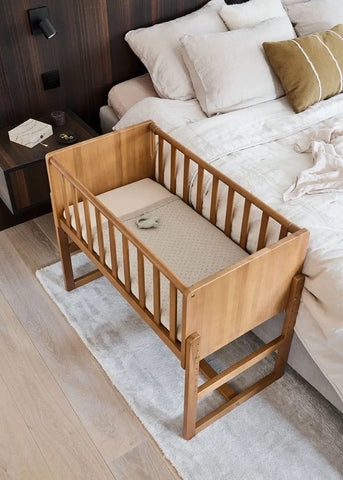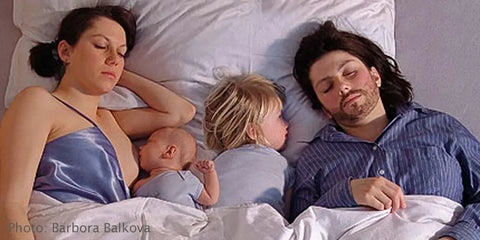Safe co-sleeping: the rules
Co-sleeping, or sleeping in the same room as your baby, is an increasingly popular practice that has many benefits, such as strengthening the parent-child bond and facilitating nighttime breastfeeding. However, it is essential to follow certain safety rules in order to provide your baby with a healthy and safe sleep environment.
The different types of co-sleeping beds
There are two main types of co-sleeping beds: independent and modular cribs, and baby beds attached to the parents' bed. Independent cribs are equipped with a removable side and wheels to make moving them easier. They are adjustable in height to adapt to all parents' beds. Baby beds attached to the parents' bed, also called "sidecars", are attached by a system of straps or fasteners, with an extension to connect the two mattresses. They can quickly be transformed into a classic bed by removing the fasteners and installing the missing wall. For those who want to keep baby close to them even when traveling, there are also portable co-sleeping beds, foldable and transportable in a storage bag.

Common mistakes to avoid
Here are some common mistakes to avoid when co-sleeping:
- Placing the baby on a soft surface such as a pillow, duvet or soft mattress, which increases the risk of suffocation. The mattress must be firm and adapted to the size of the crib.
- Leave objects in the bed such as stuffed animals, blankets or bed bumpers that pose a suffocation risk. The baby's sleeping area must be kept clear.
- Placing the co-sleeping bed too far from the parents' bed, making access to the baby difficult. The co-sleeping bed must be attached to the parents' bed, with no space between the two.
- Failure to respect the recommended room temperature, which should be between 16 and 20°C. Overheating increases the risk of sudden infant death.
By paying attention to these points and following safety recommendations, co-sleeping can be practiced serenely and offer many benefits to both parents and baby.
- Placing the baby on a soft surface such as a pillow, duvet or soft mattress, which increases the risk of suffocation. The mattress must be firm and adapted to the size of the crib.
- Leave objects in the bed such as stuffed animals, blankets or bed bumpers that pose a suffocation risk. The baby's sleeping area must be kept clear.
- Placing the co-sleeping bed too far from the parents' bed, making access to the baby difficult. The co-sleeping bed must be attached to the parents' bed, with no space between the two.
- Failure to respect the recommended room temperature, which should be between 16 and 20°C. Overheating increases the risk of sudden infant death.
By paying attention to these points and following safety recommendations, co-sleeping can be practiced serenely and offer many benefits to both parents and baby.
The impact of co-sleeping on breastfeeding

Co-sleeping promotes continued breastfeeding by creating more comfortable conditions for the mother and facilitating nighttime feedings. Babies who co-sleep are fed more frequently at night than those who sleep alone, with a shorter time interval between two feedings. This sustained rhythm stimulates milk production and encourages long-term breastfeeding, the health benefits of which are recognized. In addition, co-sleeping induces lighter sleep in babies, considered potentially protective against sudden infant death syndrome, a virtue shared by breastfeeding.


Leave a comment